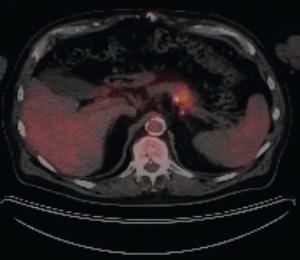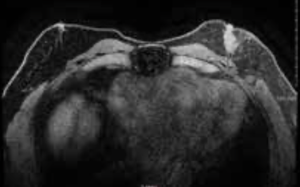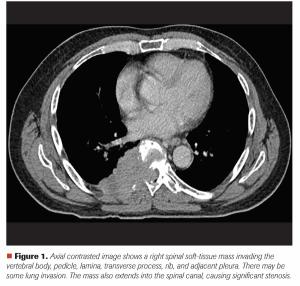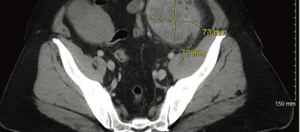Articles by Whitney Wedel, MD
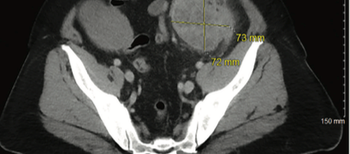
Complete Pathologic Response to Neoadjuvant Chemoimmunotherapy and Oxaliplatin-Induced Fever Associated With IL-6 Release in a Patient With Locally Advanced Colon Cancer
ByMehmet Sitki Copur, MD, FACP,Caleb W. Schroeder, MD,Quan Ly, MD,Whitney Wedel, MD,Jacqueline R. Kelly, MD, MSc,Paul Rodriguez, MD,Soe Min Tun, MD, MBA, MSc,Nicholas Lintel, MD,Adam J. Horn, MD,Bronson Riley, CGC This case presents a patient with locally advanced, unresectable, mismatch repair–deficient sigmoid colon cancer who was treated with neoadjuvant chemoimmunotherapy followed by surgical resection leading to a complete pathologic response after preoperative systemic chemoimmunotherapy.
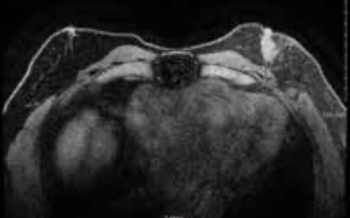
A 64-Year-Old Man With Germline BRCA2-Mutated Breast Cancer: Known and Unknown Aspects of Male Breast Cancer
ByMehmet Sitki Copur, MD, FACP,Jacqueline R. Kelly, MD, MSc,Nicholas Lintel, MD,Bronson Riley, MS,Daniel J. Herold, MD,Shellie Faris, MD,Whitney Wedel, MD,Adam J. Horn, MD This study presents a male breast cancer case with a germline BRCA2 mutation and discusses the epidemiologic, pathologic, and clinical characteristics along with treatment and follow-up recommendations in view of our recent understanding of the disease.
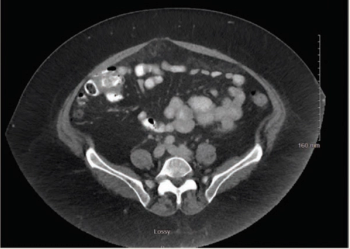
Mucinous Adenocarcinoma of the Appendix With Histologic Response to Neoadjuvant Chemotherapy: Review of Histologic and Clinical Spectrum of Epithelial Neoplastic Mucinous Lesions of the Appendix
ByMehmet Sitki Copur, MD,Allison M. Cushman-Vokoun, MD, PhD,James Padussis, MD,Whitney Wedel, MD,Caleb W. Schroeder, MD,Daniel J. Herold, MD,Nicholas Lintel, MD,Adam J. Horn, MD Mehmet Sitki Copur, MD, and colleagues examine the case of a 65-year-old patient with appendiceal mucinous neoplasms of the appendix who was treated with cytoreductive surgery and hyperthermic intraperitoneal chemotherapy.
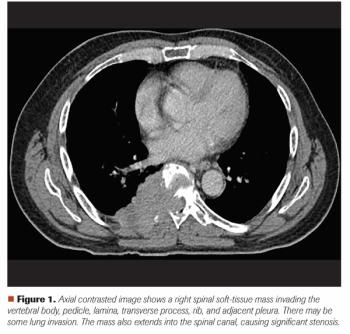
A 65-Year-Old Man With Back Pain and Imaging Findings of Spinal Cord Compression
ByMehmet Sitki Copur, MD,Scott Bell, MD, PhD, MPH,Paul Rodriguez, MD,Whitney Wedel, MD,Nicholas Lintel, MD,Thomas Zusag, MD,John L. Allen, MD Mehmet S. Copur, MD, and colleagues examine the case of a 65-year-old who presented with back pain and a large T8 spinal mass, leading to a diagnosis of multiple myeloma with spinal cord compromise.
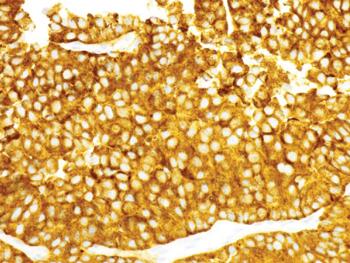
Pancreatic Neuroendocrine Tumor With Humoral Hypercalcemia and High Tumor PD-L1 Score
ByMehmet Sitki Copur, MD, FACP,Luciano M. Vargas, MD,Whitney Wedel, MD,Shaheed Merani, MD, PhD,Allison M. Cushman-Vokoun, MD, PhD,Angela Drincic, MD Abstract: Pancreatic neuroendocrine tumors (NETs) are a heterogeneous group of neoplasms. They can be functioning tumors with secretion of a variety of peptide hormones, or nonfunctioning tumors with metastases to the liver at the time of diagnosis. Well-differentiated tumors tend to be slow-growing and characterized by low tumor mutational burden (TMB) and lower propensity to express PD-L1. Hypercalcemia due to malignancy can occur in about 20% to 30% of patients with cancer. The secretion of parathyroid hormone–related protein (PTH-rP) is among the causes of malignant hypercalcemia and has seldom been associated with hypercalcemia of NETs. Although the therapeutic landscape for neuroendocrine neoplasms has evolved substantially over the past decade, the role of immunotherapy has not yet been completely explored in this group of patients. We present a rare case of a metastatic pancreatic NET with high TMB, high PD-L1 tumor proportion score, and high PTH-rP–related hypercalcemia.

Locally Advanced Gastrointestinal Stromal Tumor in a 33-Year-Old Woman Seeking to Conceive
ByMehmet Sitki Copur, MD,Allison M. Cushman-Vokoun, MD, PhD,Abigail Delaney, MD,James Padussis, MD,Whitney Wedel, MD,Scott Lauer, MD,Geoffrey A. Talmon, MD ABSTRACT
Gastrointestinal stromal tumors (GISTs) are rare neoplasms of the gastrointestinal tract. They commonly present with nonspecific symptoms and thus are often discovered incidentally. They are best identified by CT scan and most stain positive for CD117 (C-Kit), CD34, and/or DOG-1. Several risk stratification classification systems have been developed based on tumor size, mitotic rate, location, and perforation. Traditional chemotherapy and radiation therapy have been very ineffective, making surgery the mainstay of treatment. The discovery of mutations associated with these tumors has revolutionized the treatment approach. Imatinib mesylate, a selective tyrosine kinase receptor inhibitor, used as adjuvant or neoadjuvant therapy, has greatly improved the morbidity and mortality associated with GISTs. As the survival of patients has increased with the long-term use of targeted therapies, quality-of-life issues now have become much more relevant and have come to the forefront of care. We present a young woman who was successfully treated for GIST but now faces associated long-term adverse effects of imatinib, including the challenge of preserving fertility and the potential for childbearing.
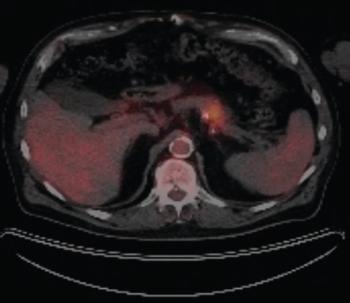
Hereditary vs Familial Pancreatic Cancer: Associated Genetic Syndromes and Clinical Perspective
ByMehmet Sitki Copur, MD, FACP,Geoffrey A. Talmon, MD,Whitney Wedel, MD,Jonathan D. Hart, MD,Shaheed Merani, MD, PhD,Luciano M. Vargas, MD Pancreatic ductal adenocarcinoma is a disease marked by high rates of mortality, with only about 7% of patients surviving 5 years after diagnosis. Here, the authors present a demonstrative case and review the available data on hereditary and familial PDAC.
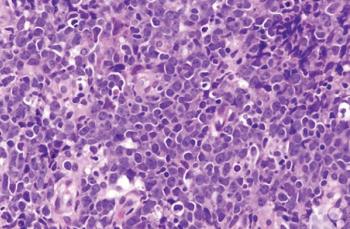
Test your diagnostic knowledge with this month's Image IQ.
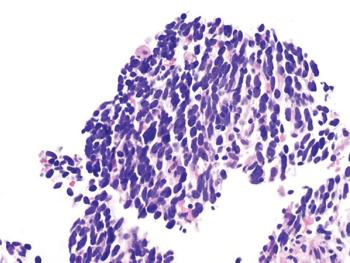
Synchronous Bilateral Lung Cancer With Discordant Histology
ByMehmet Sitki Copur, MD, FACP,Rudy P. Lackner, MD,Whitney Wedel, MD,Nikki Lintel, MD,Matthew Stritt, MD,Kalpesh Ganatra, MD Medical oncologsts discuss the case of a 70-year old woman with synchronous multiple primary lung cancer.
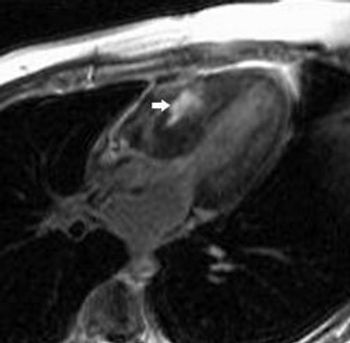
Locally Advanced Rectal Cancer, What is the Standard of Care?
ByMehmet Sitki Copur, MD, FACP,Whitney Wedel, MD,Pornchai Jonglertham, MD,Thomas Zusag, MD,Adam J. Horn, MD A 39-year-old Hispanic male presented with complaints of mucous stools, loss of appetite, rectal bleeding and a 30-pound weight loss within the past several months.

Hypercalcemia in a Patient with Small Lymphocytic Lymphoma/Chronic Lymphocytic Leukemia
ByMehmet Sitki Copur, MD, FACP,Whitney Wedel, MD,Pornchai Jonglertham, MD,Carlene Springer, APRN,Adam J. Horn, MD 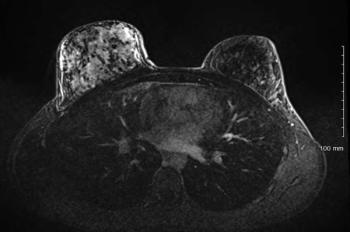
A 22-year-old Caucasian woman presents with a four month history of pain, tenderness and swelling in her right breast. What's your diagnosis?














